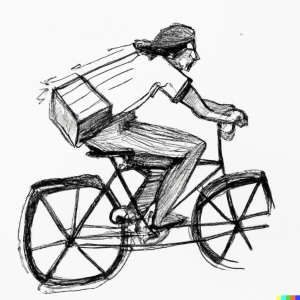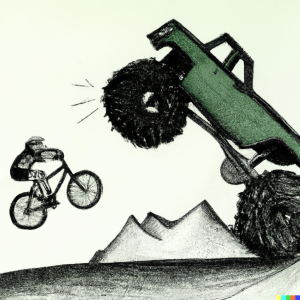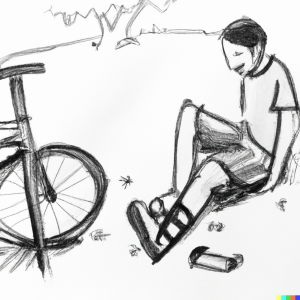Ai Images
I used Midjourney to get images of Gabe’s story. I was a short story of his time in Disney land. He was 6 year’s old in 2008. He went onto the ferris wheel ride and laughed so hard that he peed his pants, on the ride! Using Ai to obtain a scene in his story illustrated something close. With this exercise I learned that you have to be very detailed on what you want. But also sometimes it will disregard some your prompts. I said 4 people in the second photo but gave me 5. I wished I added more detail or changed the theme like, cartoon or anime.
AI Image Workshop
In-Class Visual Activity
In-Class Activity
Visual Narrative I
After reading the chapters of Understanding Comics, one of the main aspects that stood out to me was when he discusses closure saying, “This phenomenon of observing the parts but perceiving the whole has a name. It’s called closure” (McCloud 63). I think that closure is something I will want to play with and explore more in the next visual narrative assignment. With the concept of closure, I think that often times when left with a gap we decided to use what we know to patch up the space and make it whole again. I like the idea of playing with this space and in some aspects of the story leaving little bits and pieces to be determined by the reader’s imagination. This also ties in with what he says about participation, stating, “Participation is a powerful force in any medium” (McCloud 69). I think that allowing room for the imagination/participation of the readers, makes the story more interesting and engaging for them.
Another aspect of the reading that stood out to me was the section about time frames. More specifically manipulating the shape of a panel with the purpose of representing a longer period of time. This is definitely something I want to incorporate into the next visual narrative assignment. I think that time is an important aspect that can add a lot to a story especially when it is a visual narrative. With visual narratives where text is kept on the minimal end, the use of time manipulation can add a lot to a story.
Visual Narrative I
Before reading “Understanding Comics” by Scott McCloud I had no clue how much thought went into every aspect of a comic book. I thought that the layout of all comic books were just the same, especially the spaces between the panels. But McCloud explained these spaces as gutters. In these gutters, the reader is able to make the two pictures or moments and connect them together. They also allow for the reader to fill in the gaps in the story, using context clues and previous knowledge, to infer what happens next. He describes different panel-to-panel transitions where this can be done. I want to try some of these out in my story because I think they make the story a lot more interesting and unique.
Another aspect of the reading that I found very interesting and that I would like to use in my own digital storytelling is the different ways that time can be represented. There are a few different things that can be used to show that time is passing. The first way that is described is the size or amount of panels. Multiple of the same panel can be displayed to show a pause or the length of the panel can be stretched to be larger than the panels around it signifying a larger amount of time. The second way is to use text. This could either be from a conversation or representing sounds. When this text is put in order it will represent different actions and their reactions, therefore, indicating that time is passing during this. I want to use this aspect in my story because representing time is important, especially in a shorter story. I can use this to show that time is passing without needing to explain a lot.
5 Story Summaries
Classical Aristotelian 3-part structure: Lily, a young woman who just graduated from college with a degree in English doesn’t know what to do with her life now. Soon after she has graduated from college, she inherits money from her grandma. Lily has always been an adventure seeker and is in need of a newfound self-discovery when a family member passes away and she inherits a large sum of money. Lily sets off on a journey and a lot of the way she faces challenges meets new friends and uncovers a dark family secret. She is now faced with a difficult decision to make that will determine the future of herself and her family. Throughout her journey, Lily learns more about herself and beings to grow into the person she knows she is meant to be. Upon coming home, Lily is no longer clueless about what she wants to do with her life, she has everything all planned out after her eye-opening adventure.
Kishōtenketsu 4-part structure: A boy and a girl have been together all through high school and everyone thinks they are going to be together forever. However, the summer before their senior year, the girl has to move because her dad got a new job halfway across the country. They aren’t ready to give up on their relationship yet, so they try to make long-distance work. However, this did not last for long, they realized it was too difficult and they were too young and eventually, they stopped talking altogether. They have both moved on and are now getting ready to go off to college. Upon going to their first college party, by a stroke of luck (or fate) they run into each other. They have both changed a lot in the last year and spent all night catching up with each other. In the end, the couple gets back together and they are happier than they were before.
Episodic structure (at least 3 mini-stories under a main theme): This story will be based around Jake Sterling, a brilliant and tenacious detective. Each mini-story will follow Detective Sterling as he works on new cases.
Mini-Story 1: “The Small Town Murder”
Detective Sterling is called out to help with a case in the small city of Cape May, New Jersey. Cape May is a friendly town, where everyone knows each other and people feel safe like nothing could ever happen there. However, something terrible has happened in this small town. The mayor’s wife was found dead in their home. The mayor has recently upset the people in the city because he is trying to bring chain restaurants/fast food places into their small town full of family-owned businesses. To make matters worse, his affair has also just been exposed so there are plenty of suspects. Detective Sterling must unravel the truth behind the murder and catch the killer.
Mini-Story 2: “The Stolen Relic”
There has been a string of robberies of smaller items from museums around the city. But, when a valuable ancient relic worth millions is stolen from a prestigious museum, Detective Sterling is called in to catch the thief and retrieve the stolen relic.
Mini-Story 3: “The Missing Heiress”
Detective Sterling is hired by the Pearson’s a wealthy family to find their missing daughter. All they know for sure is that their daughter was last seen at a high-end nightclub. The Pearson’s are a very powerful family that has made some enemies along the way and they are afraid one of them could be involved. Detective Sterling follows a trail of clues that leads to the discovery of blackmail and a web of deceit.
Surrealist or fantastic mode: A young woman in her final year of law school was going about her typical day when she accidentally discovered she has the power to manipulate time. Law school is extremely difficult, especially in your final year. So, as any other law student would do upon discovering this power, she started by using it to give her more time to study and prepare for cases she was assisting on. However, after using her power a few times, she quickly realizes something is off. Whenever she manipulates time it changes something in the past that will eventually have far-reaching consequences in the present and future. Things start to get too out of hand and she must now start her journey fixing the damage done by her time manipulation in order to restore the natural flow of time.
A personal anecdote as a fictional story: One night in late December it started to snow. Two friends were bored and wanted to go on an adventure. They wanted to drive up into the hills to find some snow. They did not intend to be up there very long or go up very far, so they went alone in one car. It is common knowledge that you should not be going up to find snow alone especially in the dark however, they did it anyways. They had a fun time but it was around 9 pm and the snow was getting heavier, so they decided it was time to head back. However, one of the friends wanted to try to make it up this one last hill before turning around which ended up getting them stuck. With no one knowing where they are and no tools to get them out, they have to use whatever they have in the car to break them free.
5 Story Summaries
Story 1: Classical Aristotelian 3-part structure
On the Bryan family farm the sheep-herding dog Jack begins to notice that some of his sheep are disappearing and no one knows why. As the sheep’s protector, Jack takes it upon himself to get to the bottom of this mystery. He starts interviewing all the other animals on the farm trying to piece together the story. During his investigation, he runs into some dangerous situations. Finally, he is able to get to the bottom of the mystery and save the sheep.
Story 2: Kishōtenketsu 4-part structure
This story takes place on a farm in Oklahoma. In the beginning, we are introduced to the family. Then we begin to learn more about the farm, it’s animals, and their daily life taking care of everything. When one of their animals suddenly gets very sick and dies. Quickly, more animals are beginning to get sick. Worried about losing all of their animals, the farmer and his family work hard and figure out what was making the animals sick. They make the necessary changes they need to make to get their animals healthy again.
Story 3: Episodic structure
These stories are about a family and their daily life but are told through the eyes of different members of the family: the parents, children, and even pets. We will be able to see their daily struggles and know their thoughts throughout the day, giving us insight into what each of their lives is like and how they are different from each other, even though some aspects of their day may be similar. Each of these stories will show how everyone views things differently and you don’t always know what someone is going through.
Story 4: Surrealist or fantastic mode
Sarah comes home from school and walks into the front door of her house closing the door behind her. Only to realize that she is not home and the door that she walked in through has now disappeared. She was transported to another world and is now standing in the middle of a forest she has never seen before. After walking around and somewhat exploring this new world she comes across someone who tells her she has to help the beings in this world solve their problems in order to get back to her world.
Story 5: Personal anecdote as a fictional story
Hailey and her family were on vacation in Hawaii and they all wanted to go snorkeling because it was something they had never done before. Today was the perfect day, the sun was shining and the water was calm. They get in the water and begin swimming around looking for fish. But they had no luck, after half an hour of swimming they didn’t see anything. They started to get tired but Hailey decided that she would swim one more lap and she was glad that she did. She called her family to come over to her so she could show them what she found.
Visual Narrative I
When generating ideas for the visual narrative assignment, I want to stress on the whole “gutters” concept McCloud introduces as having the audience be able to try and formulate what I as the creator want them to think. As McCloud puts it, “Participation is a powerful force in ANY medium.” (McCloud 69). I utilized skrollr for a project and I found how stories can be effective in utilizing scroll navigation as well as combining these transitions to fit a scroll format. I do also want to keep in mind how McCloud talks about how even simple illustrations can be used to add contrast between either from a visual standpoint or when to convey certain emotions. I want to try and draw out my illustrations for this project and I think simple illustrations will help out, time management wise and I could add detail when required to get that audience participation.
In terms of comics and visual narratives, I gravitate towards ones where it is more anthologized according to how McCloud phrases this interpretation of comics. I don’t rely much on action in terms of my own narrative ideas and I am more attracted to the whole aspect-to-aspect and scene-to-scene format McCloud discusses in terms of transitions. While action-to-action helps to provide a sense of movement and flow within the story, I do notice how fast you can get through those portions. If I want my reader to become more immersed into the story and characters, there is at most a domination of three formats to ensure that it continues to persuade the audience to keep going.
5 Story Summaries
The characters in these story summaries are from a story I have worked on for a while. Most of the stories written for these prompts can be versions of pieces of that story idea.
- A group goes seeking a dragon to help them fix a fight between two wealthy families with ancient history within them. The search for the home of the area’s dragon guardian. They set out to travel to the mountain top at which the dragon rests.
They arrive at the dragon’s sanctum and find him. As they explain why they need him, he refuses to participate. After some conflict, they find out it is because he is a lesser dragon, with not much power over the elements. They do not stop trying until he begrudgingly agrees.
The group returns him to a courtyard at which the families agreed to gather. The families were astounded children of their own could gather together and actually bring a dragon to the meeting. Out of respect for the dragon’s statements and the group’s strength together, the two families agree upon peace between them.
- A girl named Tarisa wakes up in bed. She gets up and starts getting ready for her day. Tarisa packs her backpack and goes downstairs.
She grabs some food off the table as she says goodbye to her family. Tarisa rushes out the door to board the bus.
She climbs onto the bus and takes an empty seat, excited to go to school. As the bus drives, it is stopped. The bridge the buses usual route takes is under construction. It takes longer than normal to reach the city and get to the school. She is worried she will have missed her friends.
As the bus arrives at school Tarisa quickly gets off. Her friends had been waiting for the late bus. They all had a little time left to talk before classes began.
- A girl named Nadia is with her friends Tarisa, Gufera, and Danny, exploring the woods. They had heard rumors from freshmen at their school that an old, ruined building around here was haunted. When they finally found the rubble, it was clear looking through it would not be quick. It was the ruins of an old soul-science lab that burnt down. They decided to split up. Against Danny’s suggestion, Gufera teamed with Tarisa to scope the outside, well Nadia took Danny to look around the inside.
Tarisa and Gufera rummaged through some piles of debri outside.
“You’d think if a ghost was here, we would have visited during the night.” Gufera mumbled as she threw a rock out of her way.
“You know I’m not allowed out at night- and it would be more scary.” Tarisa exclaimed with a shutter as she looked over at what stood left of the building, knowing her friends were inside.
“You have me here. So you’ll be safe.” Gufera stated as she sat down for a break.
Nadia and Danny quietly walk down a hall coated with decay and abandonment. Stone and metal surrounding their path.
“It’s um… really quiet here. I don’t even hear little creatures…” Nadia stammered as she stepped over old wires on a cracked stone floor. Danny just gave a nervous smile as he pushed a fallen piece of a pillar off of the path. Suddenly, a screech of metal screamed through the hall. Quick to stop after a few seconds. “Did you hear that!?” Nadia squealed, Danny quickly raising a finger to his mouth as he shushes her with his eyes widened in concern.
“I heard something… I heard words… words like mine…” My voice echoes from my mouth. It has been so long since I heard words this loud and clear. I try to move, like I try every day, but my body just scratches against the fallen roof that restrains me. I hear steps now. They grow in volume, slowly but surely. I must try to move again. My body scratches and slams against the debri, I hear a gasp nearby. “Hello.” I speak, maybe it is a person, maybe they will speak back.
“Oh my gosh! Someone’s in the rubble! Danny, help me!” I hear, there are people, and they’re speaking back. I feel a shift in the weight above me, the ceiling is moving, are they moving it?
Nadia is frantically trying to pull away small rocks well Danny takes care of the bigger ones. Someone is trapped! She wonders for how long, and if they need medical help. As Nadia pulls back a slab, she notices a claw, except it’s made of metal. She touches it, and it twitches in reaction. From where it lays, she begins to dig above it where she assumes a face would be. After a few layers, she meets with a face, with skin of metal, dented, yet eyes glowing and alive look back.
- Anjie is a girl whose sister has been missing for a year now. She is bullied for having her strange older sister gone missing. She follows the notes and riddles in her sister’s special journal that contained fantasy stories and such. She eventually finds a shed in the woods behind her house from the journal’s clues, and follows a spell recipe to unknowingly create a portal. Anjie is teleported into another realm, and is now on a quest to find her sister in this different world. She is accompanied by a guardian bestowed upon her by a god-like creature that had met her sister before.
- A girl who goes through a regular day like any other, but she is plagued with monsters only she can see. Being tormented and plagued with nightmares just out of her reach. Anxiety constantly spiking from feelings and hallucinations of monsters not really there. These monsters become real when the girl snaps from the pressure and fear.
This theme is based off of the combination of the mental disorders of Maladaptive DayDreaming and Anxiety, causing hallucinations and nightmare-like daydreams throughout daily life.
5 Story Summaries
Aristotelian.
The story begins on a space station. A new experiment is about to begin, one that could change the course of human history. The experiment involves harnessing the power of a black hole to provide unlimited energy to Earth. As the experiment begins, something goes wrong and the station is thrown into chaos. The black hole’s gravitational pull becomes unstable, threatening to destroy the station and everyone on it.
They discover that the experiment has created a rip in the fabric of space-time, which is causing the instability. With time running out, the team must find a way to fix the rip and stabilize the black hole’s gravitational pull before it’s too late. They discover sabotage from a rival organization and that someone among them is not who they seem to be.
The team finally succeeds in stabilizing the black hole and fixing the rip, but at a great cost. One member sacrifices their life to save the rest, and the station is left severely damaged.
The team returns to Earth with new knowledge and a newfound appreciation for the dangers and responsibilities that come with harnessing the power of the universe. They vow to use their newfound knowledge for the betterment of humanity.
[Utilized ChatGPT]
Kishotenketsu.
A man wakes up and goes downstairs of his home, he is looking for breakfast but his refrigerator is empty. We follow him as he takes his fishing pole down to the ocean dock and begins fishing. A mermaid appears and asks him questions about the dry world. Cut to the fisherman eating a large cut of fish for dinner and being content with his catch.
Episodic.
- Takes place in a fantasy world beginning to experience industrial revolution, there are fantasy races and magic but humans and technology are beginning to supplant both. Esmund is a young paladin in training and has been sent to the city Norwood to get practical experience protecting people. He reports to the city magistrate, Fremont, an older man who oversees the city’s administration and whom is a veteran of an older war and is very protective of his people. Esmund is sent to investigate reports of a group of raiders gathering at a nearby abandoned quarry. He leaves the city and heads out, when night falls, he uses a small fire spell to light a fire and soon encounters a group of people who explain that they have heard of work being available at the quarry and that raider story was only rumor, Esmund decides that it is safest to accompany them to the quarry and survey the situation himself. When they get to the outskirts of the quarry many campsites can be seen but no mining is taking place, as Esmund turns to warn the group he is knocked unconscious by one of the men with a tree branch.
- Esmund wakes in a wooden cage without his armor, he is alone in his cage but a few others nearby seem to have families in them. He spends some time talking with the nearest group and learns that they’ve been captured for a week and that they are kidnapping people from surrounding homesteads to ransom back to the city. Esmund uses the fire spell to burn away at the back of his cage and starts to try and free the other captives, after freeing one family a guard comes by and calls out to others to stop them resulting in a fight breaking out and one of the family members being killed. The remaining escapees are overpowered and Esmund is bound and gagged and put in another cage where the body of the family member is left with him to remind him not to try and escape again. After dark one of the guards wakes him setting him free, explaining he is a guard from the city infiltrating the raiders. He gives Esmund a letter for Fremont and gets him to the nearby treeline warning him that he won’t have much of a lead so to hurry and get reinforcements.
- Esmund is waiting in Fremont’s office after getting his guards to let him into the mansion and sending them to get him. He notices many books about the nature of the gods and how the older races had communicated with them. When Fremont arrives Esmund gives him the letter from the guard and begins recounting what happened at the quarry. Fremont tells him he was a fool for thinking he could free the captives on his own but that he is glad such a good hearted person exists. Fremont calls in his captains and they begin to plan how to attack the quarry. Esmund is part of a small group sent ahead to track the raiders in case they decided to relocate since his escape, when they arrive only a fraction of the raiders are at the quarry and are easily overtaken, the prisoners explain that the rest had moved upon the city. Upon returning the group finds the remains of a battle near the city and celebration within, the raiders had attacked when the guard was already assembled and were easily defeated with many captives being taken.
- Esmund is celebrating his first successful mission and begins looking for the family that he had tried to help escape when he was captive. Talking to the citizens he can’t find any mention of the families that were taken for ransom. He urgently rushes to Fremont’s mansion to explain that the families may still be being held captive in the wilderness. The guards refuse to let him enter and tell him to meet him tomorrow at his town offices. Esmund is furious and decides to try and sneak in after dark remembering that it’s easier to be unnoticed in the shadows. That night Esmund is able to get near the estate and find his way in the servants’ entrance, he makes his way towards the office but waits outside the door when he hears voices within speaking about how the dungeons are bursting with supplies and the spectacle of the battle was good enough of a distraction. Esmund starts to retrace his way back out of the mansion but runs into a servant who starts calling for guards. Esmund escapes before being caught and decides to head to the city dungeons hoping to investigate before a warning can be sent about his snooping.
Surrealist or fantastical.
A person falls asleep at a campfire and is taken into a dreamworld. They wake in a forest of upside down trees whose roots reach high into the sky, wandering further brings them to a creek of flowing light with droplets occasionally floating up and off into the sky to become the stars, they wonder what the light would taste like but decide it best not to drink away the stars. Finally, the character comes to their campsite, but it is surrounded by different doors, opening each one shows different memories of the character’s life. They hesitate to enter any, scared to become trapped, instead they return to their sleeping bag and try to dream their way back to the waking world.
Anecdotal.
A family must return to a city in California where each generation grew up. A day long drive in a cramped car with much nervous energy, they are finalizing adoption and they will legally be a real family. The parents experience constant anxiety and fear of encountering the biological parents of their children at every stop in the city. They had moved away to escape. The special day arrives and after scrutinizing every stranger that passes by, they are ushered into the courtroom and are given legal family status, they return home and celebrate with cake.
Five Story Summaries
Five Story Summaries
1 – Aristotelian Structure
Act one – Frey and Jesse are vagabond bounty hunters wandering the last, straggled breaths of a dying American west. They accept a job from an arms-dealing businessman to save his daughter, Anna, from the grasp of a cult called the Blood Angels.
The angels are lying out in a fort, and the pair make plans to infiltrate it after sunset. While Frey manages to save Anna, Jesse is wounded, caught, and thrown in a cell. Frey and Anna reconvene in a small village, where they spend the advance reward money to hire two mercenaries.
Act two – The group returns to the fort to rescue Jesse, only to find that the angels have fled and are making their way to the West coast. They press on for several days, and eventually overtake them on the outskirts of a city, only to realize the cult has convened with its other sects, and their numbers have grown tenfold. The hired mercenaries flee. While Anna and Frey camp out, they are surrounded in the night and thrown into confinement with Jesse.
Act three – Jesse is injured, his wound infected, but he informs them that the Angels accept duel propositions from prisoners on the grounds of their fictive religion as long as they have a weapon. Jesse is immobile and Frey admits they took her gun.
The three are brought before the cult leader to receive judgment- Anna procures a hidden revolver from her ankle and proposes a duel. She narrowly wins, and the trio flees into the sunset.
2 – Kishotenketsu
For the first two acts of this story, we are introduced to Ben- he works at a hardware store and seems relatively unassuming, but he has troubles connecting with others. He hesitantly befriends a coworker named Aiden. The second act illuminates that Ben has a habit of stealing lightbulbs as he leaves work everyday. Aiden begins picking up Ben to take him to work, as he has no car.
In the third act twist, we find out he is obsessed with lighting fixtures after a personal incident that occurred in the lighting section of a hardware store. His house ceiling is plastered in chandeliers, lanterns, hanging lights, etc, making it almost unnavigable.
In the fourth act, the lights are shut off, and he has an episode, refusing to leave his house, unable to sleep, eat, or respond to texts. Eventually, Aiden visits the house, finding Ben in this state. He realizes there is an issue with the breaker and gets the lights back on. The two share a meal on the hallway floor, under the lights.
3 – Episodic Structure
The story takes place in an underground habitat called the Mulberry Warrens at winter, a burrow filled with a variety of woodland creatures i.e. Redwall. Wintertime is organically a period of hibernating and isolation from the outside world- the thematic through line would be exploring loneliness, relationships, and self improvement as the main character (A vole named Ada) waits out the snow. It would permeate comfort and lead into the final ‘episode’ being some parallel to a Christmas celebration. One episode would explore the harsh wildlife outside the warrens, but most might delve into events like feast preparations or other relatively low-stakes, interpersonal chapters.
4- Surrealist mode
1920s New York – A host of disparate and enigmatic guests flock to a lavish art installation advertised with the ability to grant its observer’s desires. At the request of an anonymous letter left at her apartment doorstep, detective Gail Ballard devises a plan to infiltrate the exhibition’s strict guest list. When she arrives, she finds herself in a parallel, architecturally abstract New York populated with stranded characters plucked across two centuries of time, with a massive, humanoid silhouette etched into the horizon where the moon should be. She finds most of this world’s inhabitants have succumbed to a fungal parasite that grants them sickly appearances and senile, exaggerated personalities. The story explores her interactions with these characters and her eventual attempts to get home.
5 – Personal Anecdote
I could probably structure some work stories episodically for this section! I have a lot of small, fun anecdotes but nothing I can think of that would function as a satisfying arc. I could use the time someone threatened to shoot us, when a coworker spilled a comically massive keg of beer in the hallway minutes before the building inspector was scheduled to get there, or when another coworker was convinced an auditorium was haunted.
Post 6: Visual Narrative
In the chapters of “Understanding Comics” by Scott McCloud, the author explores the concept of sequential art and how it creates meaning in comics. He defines sequential art as the arrangement of images over time to tell a story. McCloud also explains the role of gutters, the blank spaces between panels in a comic, in creating narrative time frames. He argues that the gutters act as a bridge between panels, allowing the reader to construct a story from the sequence of images. McCloud also explores the use of time frames in comics, such as the slow-motion effect and the overlapping of events in different panels, to create a sense of time and movement. Throughout the chapters, McCloud uses examples from different comics to illustrate his points, demonstrating the power of sequential art, gutters, and time frames in the medium of comics.
how might you approach the next visual narrative assignment?
I plan to create a video for the next visual narrative assignment. Though McCloud gives great advice and information on the use of mediums used in comics , video seems to be a great way to guide a viewers attention to help “construct a story”. Especially if there are no words said and just visuals of actions or objects. It leaves room for the audience to explore and construct the story in another way.
What do McCloud’s ideas generate for you in your own digital storytelling? Try to think outside the box.
McCloud believes that the simplicity of comic book visuals gives the visuals more power, largely because they call upon the comic book reader to help create the meaning. For my own digital story telling, I’d like to explore that in different mediums such as music, drawing (or in his way, comics and illustration), photography, maybe in just sounds or audio that don’t involve words or phrases but simply organic sounds of everyday life.
Post 4: Diagrammatic Storytelling
“Great Rock n’ Roll Pauses” is a short story by Jennifer Egan that explores themes of aging, nostalgia, and musical obsession. The story revolves around a man in his 60s named Ray, who is a lifelong music lover and former rock critic. Ray becomes obsessed with the idea of “pauses” in rock songs and begins to collect them. He becomes increasingly isolated and disconnected from the world as he fixates on these musical moments. The story ultimately culminates with a final, cathartic pause that allows Ray to come to terms with his past and find a sense of peace. Through its portrayal of a man grappling with his own mortality and the fading of his passions, “Great Rock n’ Roll Pauses” reflects on the nature of time, creativity, and the human experience.
The conflict is primarily internal and revolves around the protagonist Ray’s struggle with aging and the fading of his musical passions. Ray becomes fixated on collecting pauses in rock songs, which leads him to become increasingly isolated and disconnected from the world around him. The climax of the story is the resolution of this conflict as Ray experiences a final, cathartic pause that allows him to come to terms with his past and find a sense of peace. Through this moment, the story suggests that the resolution of personal conflict can come from a deep connection to art and creativity.
The protagonist, Ray, experiences significant inward change throughout the course of “Great Rock n’ Roll Pauses.” At the beginning of the story, he is consumed by his obsession with collecting pauses in rock songs and is disconnected from the world around him. As the story progresses, his fixation deepens and he becomes increasingly isolated. However, at the climax of the story, Ray experiences a final, cathartic pause that allows him to come to terms with his past and find a sense of peace. This resolution of his conflict represents a significant shift in his inward state, from one of obsession and disconnection to one of acceptance and resolution.
The use of a diagrammatic form in the story helps to express these elements of plot and character by visually representing the progression of Ray’s inward journey. The shifting shapes and patterns of the pauses that Ray collects mirror the shifting patterns of his thoughts and emotions, while the increasing complexity of the diagrams reflects the growing intensity of his fixation. In this way, the form of the story serves as a visual representation of the central themes of aging, nostalgia, and musical obsession.
“Great Rock n’ Roll Pauses” by Jennifer Egan is a story that effectively utilizes diagrammatic form to express its central themes and to shape the reader’s experience. This use of form inspires me to consider how I can similarly use arrangement of type to create structure, sequence, emphasis, pacing, and rhythm in my own diagrammatic story.
For example, I could use the size, color, and placement of type to create emphasis on certain elements of the story, while using negative space to create pacing and rhythm. I could also use the arrangement of type to visually represent the progression of the protagonist’s inward journey, just as Egan does in “Great Rock n’ Roll Pauses.” By considering how form can contribute to the overall narrative experience, I can craft a diagrammatic story that effectively conveys its themes and characters.
Post 3: Narrative Traditions II
“60 Characters” is a short story that explores the consequences of technology and social media on human relationships. The conflict in the story lies in the protagonist’s struggle to connect with her husband, who is consumed by his virtual life and the endless stream of characters he interacts with on social media. The protagonist finds herself feeling isolated and ignored in her own marriage as her husband becomes more and more engrossed in his virtual world.
The story evokes feelings of loneliness and disconnection, as well as the impact of technology on our relationships and daily lives. The narrative structure of “60 Characters” is straightforward, moving chronologically from the beginning to the end of the protagonist’s struggle with her husband’s obsession with social media. The use of short, fragmented sentences and the repetition of phrases such as “He was always on his phone” reinforce the protagonist’s feelings of disconnection and the overwhelming presence of technology in her life.
Overall, “60 Characters” serves as a cautionary tale about the dangers of excessive technology use and the importance of maintaining real-life connections. The story highlights the need for balance between virtual and real-life relationships and the impact that technology can have on our relationships and daily lives.

























